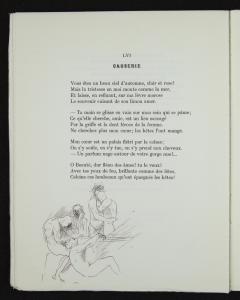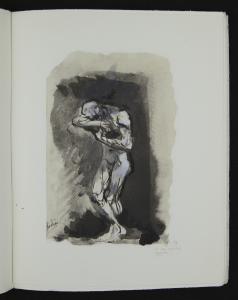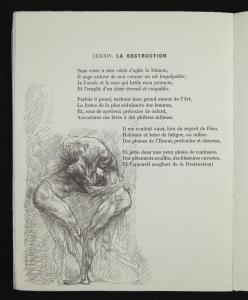

Les fleurs du mal
1. The complaint, and the consolation; or, Night thoughts
2. The Fables of Æesop, and others / With designs on wood, by Thomas Bewick
5. News from nowhere: or, An epoch of rest, being some chapters from Utopian romance
6. The nature of Gothic, a chapter of the stones of Venice
7. Daphnis and Chloe: a most sweet abd pleasant pastoral romance for young ladies
8. The Sphinx
10. Credo
14. Bible.Old Testament. Song of Solomon.
16. Kem byt’? / V. Mai︠a︡kovskiĭ ; ris. N. Shifrin.
17. The ghost in the underblows
19. Bateau ivre
UCLA Call Number: PQ2191 .F6 1940

Les fleurs du mal
The image shown here is one of 27 illustrations created by Auguste Rodin to accompany Charles Baudelaire’s classic literary work, Les Fleurs du Mal. The combination of Rodin’s artistry, combined with a focus on layout, typography and the overall quality of the book demonstrate characteristics of both the livre d’artiste and fine press traditions. Displayed here, the integration of Rodin’s illustrations with Baudelaire’s text is reminiscent of annotations in terms of how they function within the margins. Through the loose, sketch–like quality of his image, Rodin aids the viewer in understanding the extent of the sadness and despair in the poem, “Causerie” (“Conversation”). Rodin’s drawing appears to comment directly on the poem, translating the emotion of the piece into these tragic figures.

Les fleurs du mal
“L’Irrémédiable” is an example of one of the few full–page illustrations found in this edition of Les Fleurs du Mal. While six full–page reproductions of Rodin’s original ink and gouache works appear sporadically throughout the book, they are rare in comparison to Rodin’s more frequent use of vignettes. This image is based on illustrations Rodin executed for Paul Gallimard’s personal copy of Les Fleurs du Mal. In order for the Limited Editions Club to publish a fine press version of the text with its original images, they utilized a photomechanical process called the “collotype,” which involves coating a plate with sensitized gelatin, and then developing the image, by exposing it to light, much like a photograph. What results is the creation of a print matrix that picks up more ink in areas with more light exposure, or where the gelatin has hardened. In this method the plate may be inked and then printed using a rotary or offset press. (In order to faithfully reproduce Rodin’s original drawings for Les Fleurs du Mal, the Limited Editions Club employed a photomechanical process known as the collotype. “La Destruction” represents one of a total of 27 original illustrations reproduced utilizing this process, which relies on sensitized plates to transfer an image to a print matrix. The collotype is just one of many photomechanical processes that developed in the late 19th and early 20th centuries, and which correspondingly spurred an increase in the production and distribution of visual materials. Furthermore, these advances made the rise in fine press and livres d’artistes books possible, and allowed a wider audience to purchase art by notable artists, through the medium of the book.

Les fleurs du mal
By pairing Charles Baudelaire’s groundbreaking poetry cycle, Les Fleurs du Mal, with reproductions of Auguste Rodin’s original ink and gouache drawings, the Limited Editions Club of New York utilizes the livre d’artiste tradition. This tradition is characterized by high production values and the pairing of classic literary works with the work of notable artists. Although this 1940 edition integrates the work of the author and the artist more so than a true livre d’artiste, the artist’s name is still perceived as a main selling point for the book, as it is aimed at an audience that appreciates art, and is marketed as a work of art in its own right. Although the book is produced with high quality materials, in a limited edition, it does not represent the same deluxe qualities found in other livres d’artistes, which would be issued unbound, in a larger format, so that collectors could choose the binding, or so that illustrations could be separated from the text and displayed independently.
Full title
Creator: Baudelaire, Charles
Publisher:Limited Editions Club
Publication Place: Paris
Date of Publication: 1940
Dimensions 23 cm
Technologies of Production:
Physical Description:
This edition of Les Fleurs du Mal is an appropriate size for personal reading; it is not oversize, heavy, or awkward in any way. It is light in weight, with soft covers made of pastel blue paper: the title and author information are printed on the recto and the spine, in burgundy. Inside, the paper pages have a visible watermark that reads “BFK Rives France” and a portion of these pages have deckled edges. When not in use, the book is protected with an accompanying hard case in burgundy with the title and author information embossed in gold on the recto of the case.
The binding style used is a Coptic binding. In this style, several groups of pages, called gatherings, are sewn through the fold and then sewn together through the use of chain stitching across the spine.
The book itself has a very “clean” look, meaning there is no extraneous decoration other than the illustrations. The margins are wide, the flypapers and endpapers are free of decoration, and there is a uniform typeface (Didot) throughout the book. The only exception to this is the title page, which shows seven different typefaces that help to differentiate between author, title, and publisher information.
The text is interspersed with illustrations by Auguste Rodin. These illustrations are taken from Rodin’s original ink and gouache drawings, which were created specially for publisher Paul Gallimard’s personal copy of Baudelaire’s original 1857 edition of Les Fleurs du Mal.The illustrations are reproduced through the process of collotype. There are 21 illustrations of varying sizes, intermingling with the text, as well as six full–page illustrations. The drawings represent a variety of techniques; for instance, some of the illustrations display a looser, sketchier quality, while others consist of heavy line work and a greater attention to the detail of musculature. In those illustrations, shading and form are expressed through heavy cross–hatching. Many of the smaller vignettes are unsigned, but the full–page illustrations are signed.
Provenance:
This edition of Les Fleurs du Mal was printed for the members of the Limited Editions Club of New York, a publishing company founded in 1929 by George Macy. The LEC developed with the goal of publishing high quality editions of literary classics, accompanied by high quality illustrations produced by notable artists.(1) This particular copy of Les Fleurs du Mal is number 1069 out of an edition of 1500 copies. The name of the previous owner is unknown; however there is an inscription in pencil on the first page of the preface, near the spine that reads “mgm [?] 4–15–48”. While this edition was published and printed in 1940, the French language version experienced a shipping delay from Paris to New York. The delay was approximately seven years, due to the outbreak of World War II and the Nazi invasion of France. Foreign property was required to be registered; however, in order to secure the survival of the books in this edition, they were hidden and protected in a basement until it was safe to ship them to New York.(2) Endnotes: (1) Bill R. Majure. A Brief History of The Limited Editions Club. Montpelier Books & Art. Web. Accessed 27 November 2014. (2) Limited Editions Club: A Pairing of Art and Literature. Lehigh University, Library Services. Web. Accessed 27 November 2014.
Condition:
Overall, the book is in good condition, but has some areas of minor damage, such as slight discoloration or yellowing around the outer edges of the paper cover, as well as minor wear to the corners of the cover. At the top left edge, where the cover meets the spine, there is a tear approximately ¼” long. In addition, the spine is weak; the stitches are visibly pulling away from the gatherings in a portion of the book. Tapes have been added in some of the weakened areas, but are coming apart on one side [p. 36–37]. Page 60 appears discolored at the middle of the left–side margin, extending down to the bottom left corner of the page. Regarding the illustrations throughout the book, there are only two protective glassine sheets to serve as interleaving material to protect against the transfer of the image onto the facing page. As a result of the missing sheets, image transfer has occurred for certain images (see p. 60–61).
Additional Info:
This edition of Les Fleurs du Mal is one of two volumes published by the Limited Editions Club, which includes the original French language text, as well as the English translation, The Flowers of Evil. The English translation includes 24 illustrations by Jacob Epstein and a preface by James Laver.
Interpretation:
This 1940 edition of Charles Baudelaire’s seminal work, Les Fleurs du Mal represents a hybrid of the characteristics present in both livres d’artistes, as well as the Fine Press tradition. Similar to a livre d’artiste, the book’s publisher, the Limited Editions Club, produced a high–end book made from quality materials, yet unlike a true livre d’artiste, the book is bound, and is smaller in size, making it suitable for use as a personal reading copy. In contrast, livres d’artistes were frequently sold unbound so that they could be bound as the buyer saw fit, or so that the accompanying illustrations could be displayed separately and viewed as individual works of art. However, in this edition of Les Fleurs du Mal, Rodin’s illustrations comment on and complement Baudelaire’s text, following the qualities of Fine Press tradition, and serving as an integral part of the book.
The integration of text and image is an important part of the history of a book’s production. For instance, livres d’artistes most often feature the pairing of a canonical text with a contemporary illustrator. This collaboration is arranged by a publisher or art gallery to be marketed to an audience that appreciates fine art first and foremost. In this mode of production the collaboration between author and artist is artificial, thus text and image often lack a more intimate relationship. However, in this example Rodin’s illustrations demonstrate a relationship with the text, which is largely the result of the great admiration he had for Baudelaire, and his controversial classic, Les Fleurs du Mal.
Additionally, the circumstances surrounding the book’s production are quite interesting. Shown here, the 1940 edition, published by the Limited Editions Club, represents a facsimile of a commission that Rodin accepted for the publisher Paul Gallimard; however, this commission was not meant for a large production run of books, but instead for Gallimard’s personal copy of the original 1857 edition. Over a period of four months between 1887–1888, Rodin worked on 27 illustrations. (1) These illustrations were included in the text itself, and the pen and ink drawings are alternately loose and precise, in terms of the treatment of the figures. Additionally, there are six full page illustrations done with gouache and ink wash, and then tipped into Gallimard’s copy.
Rodin both admired and was influenced by the work of several writers, such as Victor Hugo, Honoré de Balzac, Gustave Flaubert, and most significantly Charles Baudelaire and Dante Alighieri. One can see the influence of these writers and their works on many of Rodin’s sculptural forms, such as his finished monuments to Balzac and Hugo, as well as in the drawings he made for a bronze bust of Baudelaire, which was never realized. (2) One of the most frequently discussed influences is the work of Dante in relation to Rodin’s Gates of Hell, yet scholars have also noted the influence of Baudelaire’s writings, specifically Les Fleurs du Mal. Rodin was known to read Baudelaire in his studio, and while Gates of Hell was not inspired by Les Fleurs du Mal specifically, the sculpture’s theme of eternal struggle was relevant to Baudelaire’s work, which illustrated the modern struggle. For Rodin, Baudelaire’s poetry expressed the individual’s search for beauty and truth amongst rapid change, alienation, and general dissatisfaction with modern society. (3)
While Rodin’s illustrations for Les Fleurs du Mal were the result of a commission initiated by the publisher Paul Gallimard, the pairing of artist and author was unique in that the artist was independently influenced by the author prior to executing the illustrations. As a result, one could argue that Rodin’s illustrations were the product of a desire to pay homage to an author and a literary work that he respected and knew well. Furthermore, the illustrations Rodin executed for Les Fleurs du Mal signify a more personal connection between artist and author than can be seen in traditional livres d’artistes, and serve to document Baudelaire’s literary influence on Rodin’s artistic output.
Endnotes
(1) “De Profundis Clamavi.” Musée Rodin. Web. Accessed 27 November 2014. http://www.musee-rodin.fr/en/collections/drawings/de-profundis-clamavi
(2) Edith Hoffman, “An Exhibition at the Musée Rodin” The Burlington Magazine 118:884 (1976): 791-793.
(3) Albert Elsen, ed. Rodin Rediscoverd. Washington: National Gallery of Art, 1981.
References
Austin, Lloyd. Poetic Principles and Practice: Occasional Papers on Baudelaire, Mallarmé, and Valéry. New York: Cambridge University Press, 1987.
Baudelaire, Charles. The Flowers of Evil. Trans. Keith Waldrop. Connecticut: Wesleyan University Press, 2006.
Benjamin, Walter. The Writer of Modern Life: Essays on Charles Baudelaire. Cambridge: Harvard University Press, 2006.
Brookner, Anita. “Art Historians and Art Critics - VII: Charles Baudelaire.” The Burlington Magazine 106:735 (1964): 269–279.
Brown, Kathryn, ed. The Art Book Tradition in Twentieth–Century Europe. London: Ashgate Publishing, Ltd., 2013.
“De Profundis Clamavi.” Musée Rodin. Web. Accessed 27 November 2014.
http://www.musee-rodin.fr/en/collections/drawings/de-profundis-clamavi
Elsen, Albert, ed. Rodin Rediscoverd. Washington: National Gallery of Art, 1981.
Graphics Atlas. “Identification.” Web. Accessed 22 November 2014.
< http://www.graphicsatlas.org/identification/>
Haskell, Eric T. “Illustrations for Baudelaire’s Les Fleurs du Mal: Symbolist Dreams and Decadent Nightmares.&rddquo; Symposium 38:3 (1984): 179–195.
Hoffman, Edith. “An Exhibition at the Musée Rodin” The Burlington Magazine 118:884 (1976): 791–793.
Kaplan, Art and Duncan Stulik. “Collotype.”The Atlas of Analytical Signatures of Photographic Processes. Los Angeles: Getty Conservation Institute, 2013. Web. Accessed. 12 December 2014.
http://www.getty.edu/conservation/publications_resources/pdf_publications/pdf/atlas_collotype.pdf>
“Les Fleurs du Mal (The Flowers of Evil).” http://www.musee-rodin.fr/en/collections/archives/les-fleurs-du-mal-flowers-evil Accessed 22 November 2014.
Lewis, Pericles. “Les Fleurs du Mal (The Flowers of Evil).” Modernism Lab at Yale University. Web. Accessed 12 December 2014.
http://modernism.research.yale.edu/wiki/index.php/Les_Fleurs_du_Mal_(The_Flowers_of_Evil)
Majure, Bill R. A Brief History of The Limited Editons Club. Montpelier Books & Art. Web. Accessed 27 November 2014. http://www.majure.net/lechistory.htm
Limited Editions Club: A Pairing of Art and Literature. Lehigh University, Library Services. Web. Accessed 27 November 2014. http://library.lehigh.edu/omeka/archive/files/56fd9b9f77aaa213f654529f10d05fc5.jpg
Silverman, Willa Z. The New Bibliopolis: French Book Collectors and the Culture of Print, 1880–1914. Toronto: University of Toronto Press, 2008.
Text Content Description :
Les Fleurs du Mal or, The Flowers of Evil, is Charles Baudelaire’s controversial lyric poetry cycle, which, in 1857, was found “injurious to public morality” according to the French court of law. At the time, six of Baudelaire’s original poems were deemed obscene or immoral, and were subsequently banned. Although the ban was not lifted until 1949 in France, the poems were frequently printed in posthumous editions, as they are here. (1)
The overall theme of Les Fleurs du Mal is man’s struggle, in relation to the modern world. This struggle is suggested through poems that focus on the search for passion and ideal beauty, while simultaneously navigating an unfamiliar landscape. Baudelaire’s new, unfamiliar landscape is one brought about by rapid technological advances that occurred throughout the nineteenth century. As a result, the city becomes a source of fear, shock, and alienation. Developments such as steam power and photographic processes lead to the growth of factories, train travel, and whole new methods of creating and distributing images. These elements help contribute to increased stimuli and a sense of loneliness felt on the modern city street.
The focus of Baudelaire’s poetry frequently deals with subjects such as death, monsters, and women. While the book was originally arranged according to six themes, critics suggest that the poems could also be segregated into three cycles which correspond to Baudelaire’s muses and the type of love each represents, Jeanne Duval (carnal love), Madame Sabatier (spiritual love), and Marie Daubrun (a combination of the two). (2)
Endnotes:
(1) Baudelaire, Charles. The Flowers of Evil. Trans. Keith Waldrop. Connecticut: Wesleyan University Press, 2006.
(2) Lewis, Pericles. “Les Fleurs du Mal (The Flowers of Evil).” Modernism Lab at Yale University. Web. Accessed 12 December 2014.